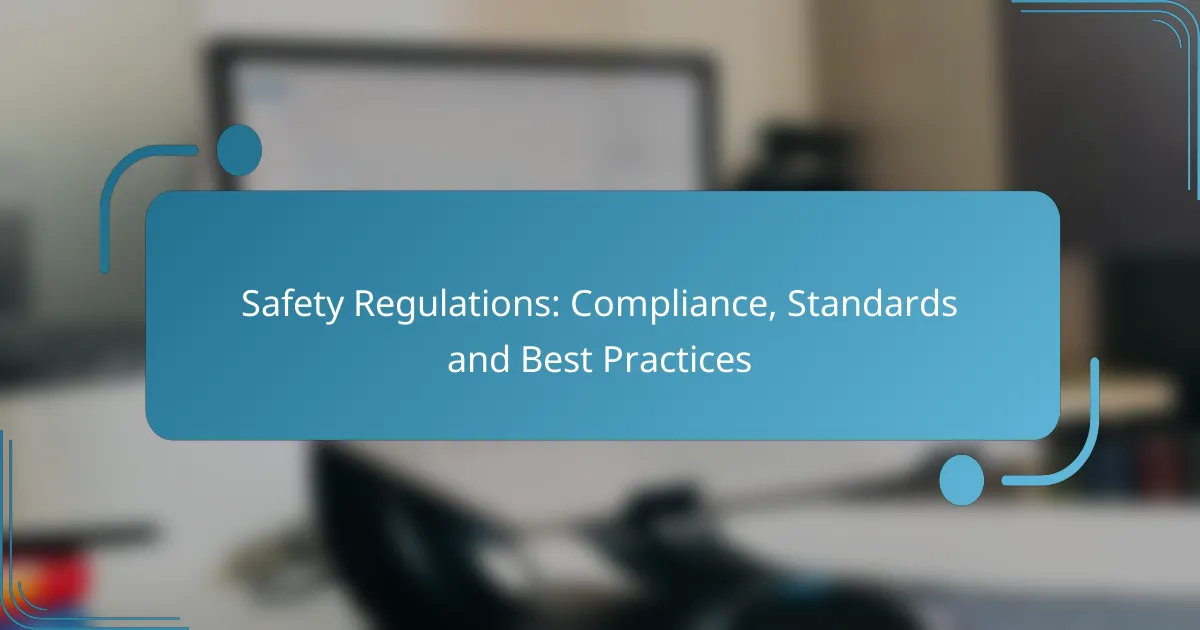Safety regulations play a crucial role in safeguarding workers, the environment, and public health in the United States. Adhering to these standards not only helps businesses avoid legal repercussions but also fosters a safe and healthy workplace. Implementing systematic compliance measures, such as regular audits and employee training, alongside best practices like establishing a safety culture, is essential for effective risk management.

What are the key safety regulations in the United States?
The key safety regulations in the United States include standards set by various agencies to protect workers, the environment, and public safety. Compliance with these regulations is essential for businesses to ensure a safe and healthy workplace while avoiding legal penalties.
Occupational Safety and Health Administration (OSHA) standards
OSHA standards are designed to ensure safe and healthful working conditions for employees across various industries. Employers must comply with regulations that cover everything from hazardous materials to workplace ergonomics.
Key OSHA standards include the General Duty Clause, which requires employers to provide a workplace free from recognized hazards, and specific regulations for industries like construction and healthcare. Regular training and safety audits are crucial for compliance.
Environmental Protection Agency (EPA) regulations
The EPA regulates environmental safety through laws aimed at protecting air, water, and land from pollution. These regulations impact industries such as manufacturing, agriculture, and waste management, requiring adherence to standards that limit emissions and waste disposal.
Businesses must obtain permits for activities that may affect the environment and regularly monitor their compliance with EPA standards. Failure to comply can result in significant fines and remediation costs.
National Fire Protection Association (NFPA) codes
The NFPA develops codes and standards to reduce the risk of fire and related hazards. These codes are widely adopted across various sectors, including residential, commercial, and industrial settings.
Key NFPA codes include NFPA 70 (National Electrical Code) and NFPA 101 (Life Safety Code), which provide guidelines for fire prevention and safety measures. Regular training and drills are essential for ensuring compliance and preparedness in case of fire emergencies.

How to ensure compliance with safety regulations?
Ensuring compliance with safety regulations involves a systematic approach that includes regular audits, employee training, and the use of compliance management tools. These steps help organizations meet legal standards and maintain a safe work environment.
Conduct regular safety audits
Regular safety audits are essential for identifying potential hazards and ensuring compliance with safety regulations. These audits should be conducted at least annually, but more frequent assessments can be beneficial, especially in high-risk industries.
During an audit, evaluate equipment, work practices, and safety protocols. Use checklists to ensure all areas are covered, and involve employees in the process to gain insights from their experiences.
Implement employee training programs
Employee training programs are crucial for fostering a culture of safety and ensuring that all staff understand safety regulations. Training should be tailored to specific roles and updated regularly to reflect changes in regulations or procedures.
Consider using a mix of training methods, such as hands-on workshops, online courses, and safety drills. Regular refresher courses can help reinforce knowledge and keep safety top of mind.
Utilize compliance management software
Compliance management software can streamline the process of tracking safety regulations and managing audits. These tools often include features for documentation, reporting, and reminders for training sessions or audits.
When selecting software, look for user-friendly options that allow for easy integration with existing systems. Many solutions offer customizable dashboards to monitor compliance status and generate reports for management review.

What are the best practices for workplace safety?
Best practices for workplace safety involve creating a proactive environment where hazards are identified and mitigated. This includes establishing a safety culture, utilizing personal protective equipment (PPE), and maintaining clear communication channels among all employees.
Establish a safety culture
Creating a safety culture means prioritizing safety at all levels of the organization. This can be achieved by involving employees in safety discussions, encouraging reporting of unsafe conditions, and recognizing safe behaviors.
Training sessions and regular safety meetings can reinforce the importance of safety. Leadership should model safe practices, as their behavior sets the tone for the entire workplace.
Utilize personal protective equipment (PPE)
Personal protective equipment is essential for minimizing exposure to workplace hazards. Depending on the industry, this may include helmets, gloves, goggles, and respiratory protection.
Employers should conduct a risk assessment to determine the appropriate PPE needed for various tasks. Regular training on the correct use and maintenance of PPE is crucial to ensure its effectiveness.
Maintain clear communication channels
Effective communication is vital for workplace safety. Establishing clear channels allows employees to report hazards, share safety information, and discuss concerns without hesitation.
Utilizing tools such as safety bulletins, digital platforms, and regular team meetings can enhance communication. It’s important to ensure that all employees, including those who may speak different languages, understand safety protocols and procedures.

What are the consequences of non-compliance?
Non-compliance with safety regulations can lead to significant repercussions for businesses, including financial penalties, increased accident rates, and potential legal action. Organizations must understand these consequences to prioritize adherence to safety standards.
Fines and penalties from regulatory bodies
Regulatory bodies impose fines and penalties to enforce compliance with safety regulations. These financial repercussions can range from hundreds to thousands of dollars, depending on the severity of the violation and the specific regulations breached. In some cases, repeated non-compliance can lead to escalating fines or even business license revocation.
Companies should regularly review their compliance status to avoid these costly penalties. Establishing a proactive safety management system can help identify potential issues before they result in fines.
Increased risk of workplace accidents
Non-compliance significantly raises the likelihood of workplace accidents, which can lead to injuries or fatalities. When safety protocols are ignored, employees may be exposed to hazardous conditions, increasing the chance of incidents. This not only affects employee well-being but can also disrupt business operations.
To mitigate this risk, organizations should conduct regular safety training and audits. Implementing a culture of safety can help ensure that all employees are aware of and adhere to necessary safety practices.
Legal liabilities and lawsuits
Failure to comply with safety regulations can result in legal liabilities and lawsuits against the organization. If an accident occurs due to non-compliance, affected employees or their families may pursue legal action, leading to costly settlements or judgments. This can severely impact a company’s financial stability and reputation.
To protect against legal risks, businesses should maintain comprehensive documentation of safety practices and compliance efforts. Consulting with legal experts on safety regulations can also provide guidance on minimizing liability exposure.

What frameworks help in assessing safety standards?
Frameworks such as ISO 45001 and ANSI Z10 provide structured approaches for organizations to evaluate and enhance their safety standards. These frameworks help ensure compliance with regulations and promote a culture of safety within the workplace.
ISO 45001 Occupational Health and Safety Management
ISO 45001 is an international standard that outlines requirements for an occupational health and safety management system (OHSMS). It aims to improve employee safety, reduce workplace risks, and create better working conditions.
Organizations implementing ISO 45001 should focus on risk assessment, employee involvement, and continuous improvement. Regular audits and management reviews are essential to ensure compliance and effectiveness of the safety management system.
For practical application, companies can start by conducting a gap analysis to identify areas needing improvement. Setting measurable objectives and involving employees in safety initiatives can enhance engagement and compliance.
ANSI Z10 Safety and Health Management Systems
ANSI Z10 is a standard that provides a framework for establishing, implementing, and continually improving safety and health management systems in the workplace. It emphasizes a proactive approach to identifying and managing hazards.
Key components of ANSI Z10 include leadership commitment, employee participation, and a focus on performance measurement. Organizations should develop a systematic approach to hazard identification and risk assessment to align with this standard.
To effectively implement ANSI Z10, companies can create a safety committee to oversee the development of policies and procedures. Regular training and communication about safety practices are crucial for fostering a culture of safety among employees.

How do safety regulations vary by industry?
Safety regulations differ significantly across industries due to varying risks, operational environments, and regulatory bodies. Each sector must adhere to specific standards and practices that address its unique hazards and compliance requirements.
Construction industry regulations
The construction industry is governed by strict safety regulations aimed at minimizing risks associated with site work, equipment use, and worker safety. Key regulations include the Occupational Safety and Health Administration (OSHA) standards in the United States, which mandate safety training, proper use of personal protective equipment (PPE), and fall protection measures.
Construction firms should conduct regular safety audits and training sessions to ensure compliance. Common pitfalls include neglecting to update safety protocols as new regulations emerge or failing to provide adequate training for new employees. A checklist for compliance might include verifying PPE availability, ensuring scaffolding safety, and conducting site inspections.
Manufacturing safety standards
Manufacturing safety standards focus on protecting workers from hazards related to machinery, chemicals, and ergonomic risks. Regulations like OSHA standards and the National Fire Protection Association (NFPA) codes play a crucial role in establishing safety protocols for equipment operation, material handling, and emergency response.
Manufacturers should prioritize regular maintenance of machinery and provide comprehensive training on safe operating procedures. A practical approach includes implementing a safety management system that tracks incidents and compliance, as well as conducting periodic risk assessments. Common mistakes include underestimating the importance of ergonomics and neglecting to update safety equipment as technology advances.








